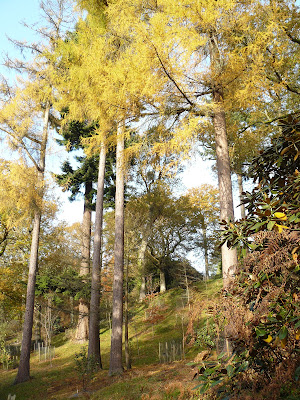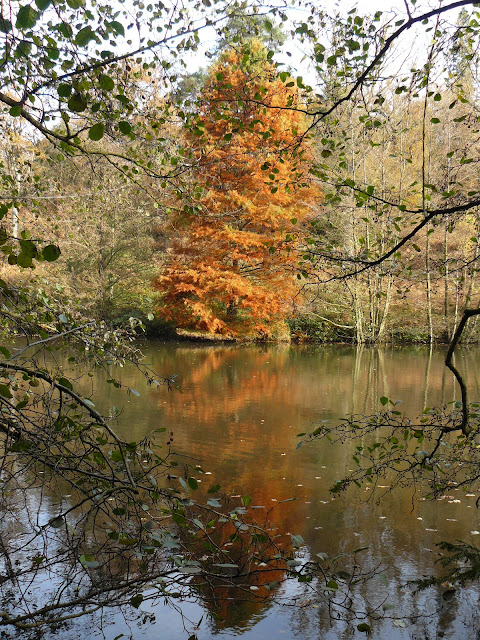For illustrated talks on natural history and history see www.peterlovetttalks.co.uk
For illustrated talks on natural history and history click here for www.peterlovetttalks.co.uk
Saturday 18 December 2010
Wednesday 15 December 2010
Wood pigeons are a pest! Eat more of them!
I'm doing my bit by roasting four of them on a bed of parsnips, with chestnut puree, potatoes and leeks au gratin, plus carrots, sprouts and boiled potatoes.
And my children thoroughly enjoyed them. It is hard being a pensioner -- forced to eat wild game to keep down costs., which indeed I did. Thanks to Cuckfield local's market in the Talbot, wood pigeons were on sale at six for £5. Buy local and eat local; especially pigeons!
And my children thoroughly enjoyed them. It is hard being a pensioner -- forced to eat wild game to keep down costs., which indeed I did. Thanks to Cuckfield local's market in the Talbot, wood pigeons were on sale at six for £5. Buy local and eat local; especially pigeons!
Monday 13 December 2010
If you go down to the woods today....
If you go down to the woods today....
You're sure of a big surprise...
Because today's the day that the [New England Wood Trust] volunteers have their [end-of-year-celebration] picnic.
And a jolly good time was had by all.
You're sure of a big surprise...
Because today's the day that the [New England Wood Trust] volunteers have their [end-of-year-celebration] picnic.
And a jolly good time was had by all.
Sunday 12 December 2010
Wilmington to Jevington circular walk
This 8.5 miles walk, from the Mid Sussex Ramblers' programme, lead by Paul, passed under the Long Man, which was shrouded in mist and frost.
From the ridge of the Downs were fine views of Alfriston and its church, zoomed below.
Ascending a sheltered valley, the hawthorns were festooned with litchens in an amazing way.
In the 12th century St Mary's churchyard, Wilmington, is an even older yew tree.
As you can see, it needs a little assistance to remain standing.
Click on any picture to expand it.
Thanks Paul and Sue for a great walk.
From the ridge of the Downs were fine views of Alfriston and its church, zoomed below.
Ascending a sheltered valley, the hawthorns were festooned with litchens in an amazing way.
In the 12th century St Mary's churchyard, Wilmington, is an even older yew tree.
As you can see, it needs a little assistance to remain standing.
Click on any picture to expand it.
Thanks Paul and Sue for a great walk.
Tuesday 7 December 2010
More frosty weather
Today's walk, from the Mid Sussex Ramblers' programme started at Ardingly reservoir. There the frost had melted on the trees. As we climbed only a few hundred feet higher towards Balcombe, we entered a still-freezing zone that was magical.
Frosted holly.
Click on pictures to expand them.
How about this for an interested sky?
My meteorologist brother Rick, observed that "Looks like stratocumulus to me - a typical layer cloud. Vertical development is limited by a temperature inversion.
Generally the lines of cloud (called streets) will be at 90 degress with the wind direction.
The bends in the lines are probably caused by orographic effects - surface physical features like hills.
Hope this helps."
Generally the lines of cloud (called streets) will be at 90 degress with the wind direction.
The bends in the lines are probably caused by orographic effects - surface physical features like hills.
Hope this helps."
Thanks Rick. I'm not quite sure what an orographic effect is but the sky looks impressive.
Underneath the railway viaduct near Balcombe.
Monday 6 December 2010
The Snow in Surrey lasts longer than in Sussex!
It was almost Arctic in Surrey this morning. And Yes! It was me that cleared this pavement of snow. Why don't we follow the German practice of clearing snow outside our properties and banish the UK urban myth of being sued if you clear it and someone falls over?
Wake up UK! The English are rather insular in their thinking. Think about the "Big Society" and clear your own roads and pavements, as happened here.
Meanwhile, in Sussex, my rubbish bin was rather beautifully decorated by a hardy spider, don't you think?
Wake up UK! The English are rather insular in their thinking. Think about the "Big Society" and clear your own roads and pavements, as happened here.
Meanwhile, in Sussex, my rubbish bin was rather beautifully decorated by a hardy spider, don't you think?
Saturday 4 December 2010
Thursday 2 December 2010
Winter weather
Gardening today consists of knocking the snow off shrubs, whose branches might otherwise break under the weight of snow.
No driving today. My camera was in the boot of the car, which is the only reason that the snow is brushed off.
New England wood was very pretty but hard work walking in two feet of snow. I didn't go far.
No driving today. My camera was in the boot of the car, which is the only reason that the snow is brushed off.
New England wood was very pretty but hard work walking in two feet of snow. I didn't go far.
Monday 15 November 2010
The Sunny High Weald
When the weather forecast is for fog, it is a pleasure to be high enough in the High Weald to be able to look across the foggy Low Weald to Chanctonbury Hill, emerging from the fog line.
Wednesday 10 November 2010
Save our Badgers
Contrary to all the scientific evidence, the government seems intent on needlessly culling badgers. Please visit www.badgertrust.org.uk and www.Save-Me.org.uk to make your voice heard, if you no longer believe in outdated ideas like burning witches or culling badgers.
Sunday 7 November 2010
Deciduous conifers at Wakehurst Place
Tomorrow the winds and rain may strip these trees of their needles and colours. So I thought to share these pictures with you. Above is the European larch.
Click on any picture to enlarge it.
Quite different from our European larch is....
Above is a larch from Japan.
It is not just the larch family of conifers that are deciduous, above is the Dawn Redwood.
The most spectacular colour is the Swamp cypress
Here is another specimen. Enjoy!
Click on any picture to enlarge it.
Quite different from our European larch is....
Above is a larch from Japan.
It is not just the larch family of conifers that are deciduous, above is the Dawn Redwood.
The most spectacular colour is the Swamp cypress
Here is another specimen. Enjoy!
Wednesday 3 November 2010
A Jurassic coast walk from Seaton to Sidmouth, 2nd November 2010
The Jurassic coast and the South West coastal path in Devon are awesome. We took a bus from from Sidmouth to Seaton, from whence we started our walk.
There is typically 160m of ascent and descent into and out of these beaches.
These hills are hard work.
A section of reasonably level woodland with epiphytic ferns was a welcomed "rest".
There is a way to go yet to Sidmouth.
And the valleys yet to be traversed are high and steep!
The ravens were always entertaining.
We now have to go down to the beach.... and, of course, up 160m to the other side.
Now we have to get back up to the top of the cliff.
That was a hard climb, believe me.
Salcombe mouth and just one more vicious climb to go.
These pretty cows were friendlier than they looked. All along this route, the animals are so used to walkers that they ignore you to the point where heifers will walk down a steep set of steps and expect you to get out of their way! I had to shout a bit -- politely -- to continue walking at one point, where steers and heifers blocked the path.
This fine mushroom might be a Parasol, which is delicious to eat...

...or it might be a Freckled Dapperling, which is mildly poisonous.
I have eaten both and can not recommend the latter.
Note the white patch on the hill, that we walked right past. Below is the explanation.
After nearly six hours walking, this final valley was draining of any energy that we had left. At least Sidmouth was in sight.
Ahhhh! Sidmouth and civilisation.
Nearly there, to the welcoming luxury of the Hotel Riviera.
The Hotel Riviera is one of the finest hotels that I have stayed in.
Looking back towards Seaton after a steady climb.
Beer is a pretty village with Pubs, but we had a long way to go with some gruelling, steep valleys to negotiate so did not stop.
Climbing the hill out of the village, the allotments had potatoes still growing in November! There are no frosts here; a place where I could enjoy to live.
Wild Irises were seeding all along the path.
Looking back towards Beer and Seaton, you can see just how this coast resembles a layered cake (the strata) thrust though 45 degrees and sliced off.
What a contrast between the red mudstone and the white chalk cliffs.
Looking backwards, Seaton was rapidly disappearing into the distance as we continued westwards towards some wilder cliffs.
The wind was so strong here, that at times, it took your breath away.
This bird also took my breath away.
How I wanted this to be a peregrine. It looks more like a female Kestrel though; magnificent none the less.
Click on any picture to expand it.
Isn't this great?
The kestrels were being mobbed by ravens, which were numerous, playing around in the updrafts on these cliffs.
The coastal path descends the cliffs to Branscombe..
There is typically 160m of ascent and descent into and out of these beaches.
These hills are hard work.
A section of reasonably level woodland with epiphytic ferns was a welcomed "rest".
There is a way to go yet to Sidmouth.
And the valleys yet to be traversed are high and steep!
The ravens were always entertaining.
We now have to go down to the beach.... and, of course, up 160m to the other side.
Now we have to get back up to the top of the cliff.
That was a hard climb, believe me.
Salcombe mouth and just one more vicious climb to go.
These pretty cows were friendlier than they looked. All along this route, the animals are so used to walkers that they ignore you to the point where heifers will walk down a steep set of steps and expect you to get out of their way! I had to shout a bit -- politely -- to continue walking at one point, where steers and heifers blocked the path.
This fine mushroom might be a Parasol, which is delicious to eat...

...or it might be a Freckled Dapperling, which is mildly poisonous.
I have eaten both and can not recommend the latter.
Note the white patch on the hill, that we walked right past. Below is the explanation.
After nearly six hours walking, this final valley was draining of any energy that we had left. At least Sidmouth was in sight.
Ahhhh! Sidmouth and civilisation.
Nearly there, to the welcoming luxury of the Hotel Riviera.
The Hotel Riviera is one of the finest hotels that I have stayed in.
Subscribe to:
Posts (Atom)























































































